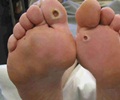Recently compiled guidelines originating in Australia for foot diseases related to diabetes have been consolidated.

New Australian guidelines for diabetes-related foot disease
Go to source) formulated by Diabetes Feet Australia, mark the first update since 2011. These guidelines, endorsed by //ten national peak bodies, aim to enhance the quality of care, with improvements and updates observed compared to the previous version. Professor Stephen Twigg, co-author of the guideline summary, emphasized the importance of well-directed and implemented guidelines in supporting quality care. He noted that the practical development of up-to-date clinical care guidelines can significantly improve health care outcomes, particularly for individuals dealing with foot disease.
Australia's Diabetes-Related Foot Disease Crisis
In Australia, diabetes-related foot disease stands as a prominent cause of hospitalization, amputation, disability, and healthcare costs. Annually, an estimated 300,000 Australians are at risk of developing diabetes-related foot disease.‘The new guidelines involve a novel risk stratification system for screening individuals without diabetes-related foot disease. It includes more precise self-monitoring, footwear prescription, and surgical treatments. #footmouthdisease #diabetes
’





An overview of the guidelines: The Medical Journal of Australia (MJA) has outlined the 98 recommendations from six new guidelines designed for the general medical audience:
- Prevention — inclusive of screening, education, self-care, footwear, and treatments aimed at averting diabetic foot disease.
- Classification — incorporating systems for ulcer, infection, ischaemia, and auditing.
- Peripheral artery disease — covering examinations and imaging for diagnosis, severity classification, and treatments.
- Infection — addressing examinations, cultures, imaging, and inflammatory markers for diagnosis, severity classification, and treatments.
- Offloading — encompassing pressure offloading treatments tailored to various ulcer types and locations.
- Wound healing — involving debridement and the selection of wound dressings.
Reference:
- New Australian guidelines for diabetes-related foot disease - (https://www.mja.com.au/journal/2023/219/9/new-australian-guidelines-diabetes-related-foot-disease)











